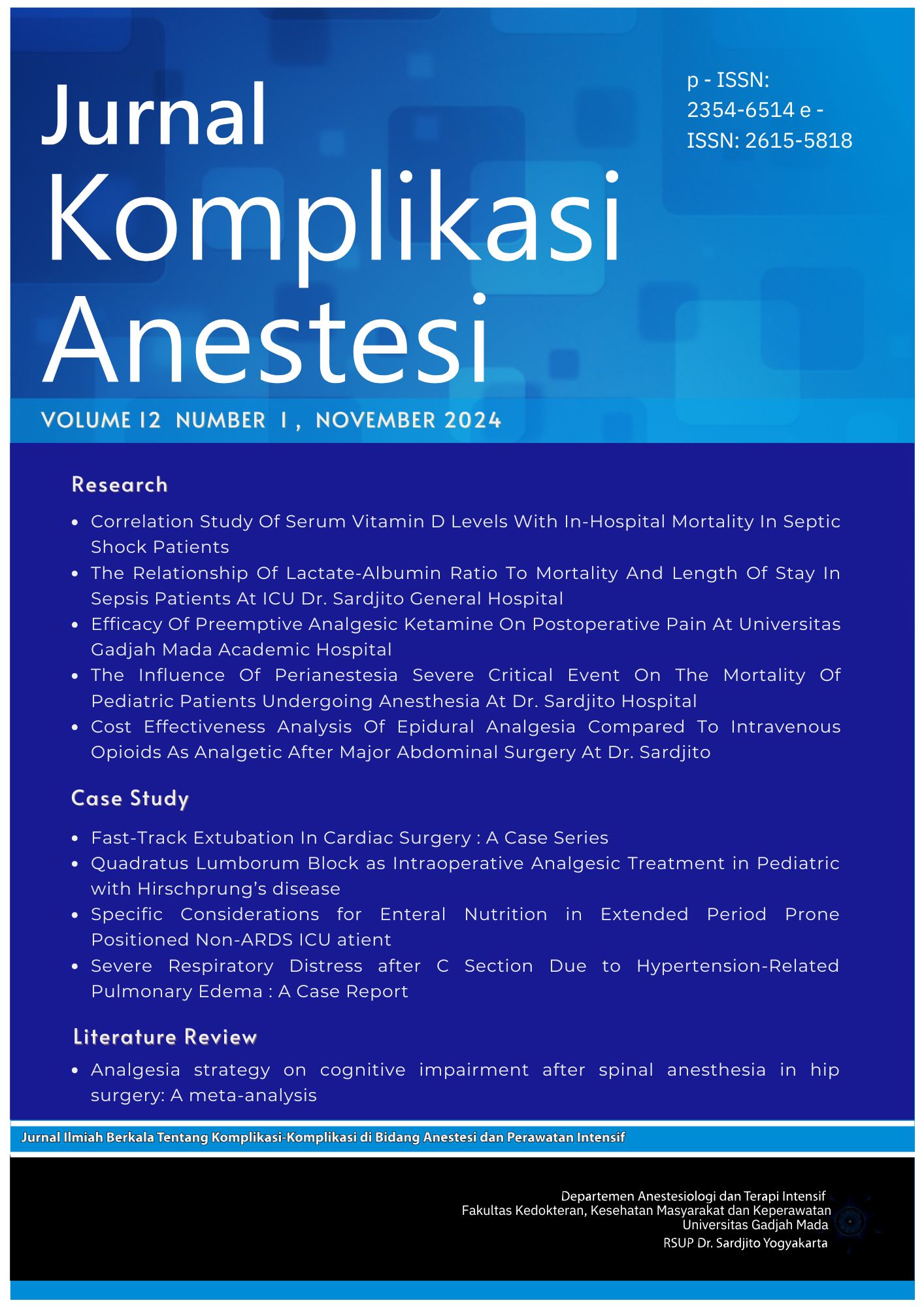THE INFLUENCE OF PERIANESTESIA SEVERE CRITICAL EVENT ON THE MORTALITY OF PEDIATRIC PATIENTS UNDERGOING ANESTHESIA AT DR. SARDJITO HOSPITAL
Abstract
Background: severe critical events or unwanted and preventable incidents associated with anesthesia in pediatrics have a higher incidence rate compared with adults. It could be due to the immature anatomy, physiology, pharmacology, emotional, and social aspects of pediatric patients. In addition to the higher incidence, the mortality rate of severe critical events in pediatric patients is also higher than in adults. In general, severe critical events in pediatric patients include difficult airway, cardiovascular events, and medical negligence. Based on the time of occurrence, those events can happen pre-anesthesia, during anesthesia, or post-anesthesia with different incidence numbers.
Purpose: To assess the impact of critical events during peri-anesthesia on the mortality rate of pediatric patients. Such events include bronchospasm, laryngospasm, pulmonary aspiration, stridor, croup, desaturation, hypotension, arrhythmia, hemorrhage, cardiac arrest, anaphylaxis, neuro injury, delayed emergence, and medication errors.
Method: This is a prospective cohort study. All pediatric patients who underwent anesthesia for surgical and non-surgical procedures at RSUP Dr. Sardjito hospital are consecutively included in this study. The inclusion criteria for this study are pediatric patients less than 18 years of age who underwent anesthesia procedures at RSUP Dr. Sardjito hospital. The exclusion criteria are patients who have no complete medical records. The severe critical events included in this study are bronchospasm, laryngospasm, pulmonary aspiration, stridor, croup, desaturation, hypotension, arrhythmia, hemorrhage, cardiac arrest, anaphylaxis, neuro injury, delayed emergence, and medication errors. To statistically assess the relationship between severe critical events and mortality outcomes, bivariate analysis using chi-square was used. Multivariate analysis was then conducted using logistic regression on the variables that had a p-value of less than 0.25 on the bivariate analysis. A p-value of less than 0.05 indicates statistical significance.
Result: From the 425 research participants, 70 severe critical events happened in 39 patients, in which 14 cases resulted in mortality were recorded. The multivariate analysis showed that severe critical events of cardiac arrest (p=0,004; OR= 52,259; 95%CI= 3,505 – 779,081) and laryngospasm (p=<0,001; OR= 46,394; 95%CI= 6,001 – 358,640) significantly associated with patient mortality. Patient's demographic of ASA status (p=0,016; OR= 6,056; 95%CI= 1,403-26,139) and prematurity history (p=0,011; OR= 7,730; 95%CI= 1,607-37,193) are shown to be significantly associated with patient mortality.
Conclusion: There is a statistically significant relationship between severe critical events of cardiac arrest and laryngospasm with the mortality of pediatric patients who undergo anesthesia in RSUP Dr. Sardjito hospital.
Copyright (c) 2024 Annika Napitu, Yunita Widyastuti, Djayanti Sari

This work is licensed under a Creative Commons Attribution-ShareAlike 4.0 International License.
The Contributor and the company/institution agree that all copies of the Final Published
Version or any part thereof distributed or posted by them in print or electronic format as permitted herein will include the notice of copyright as stipulated in the Journal and a full citation to the Journal.

















